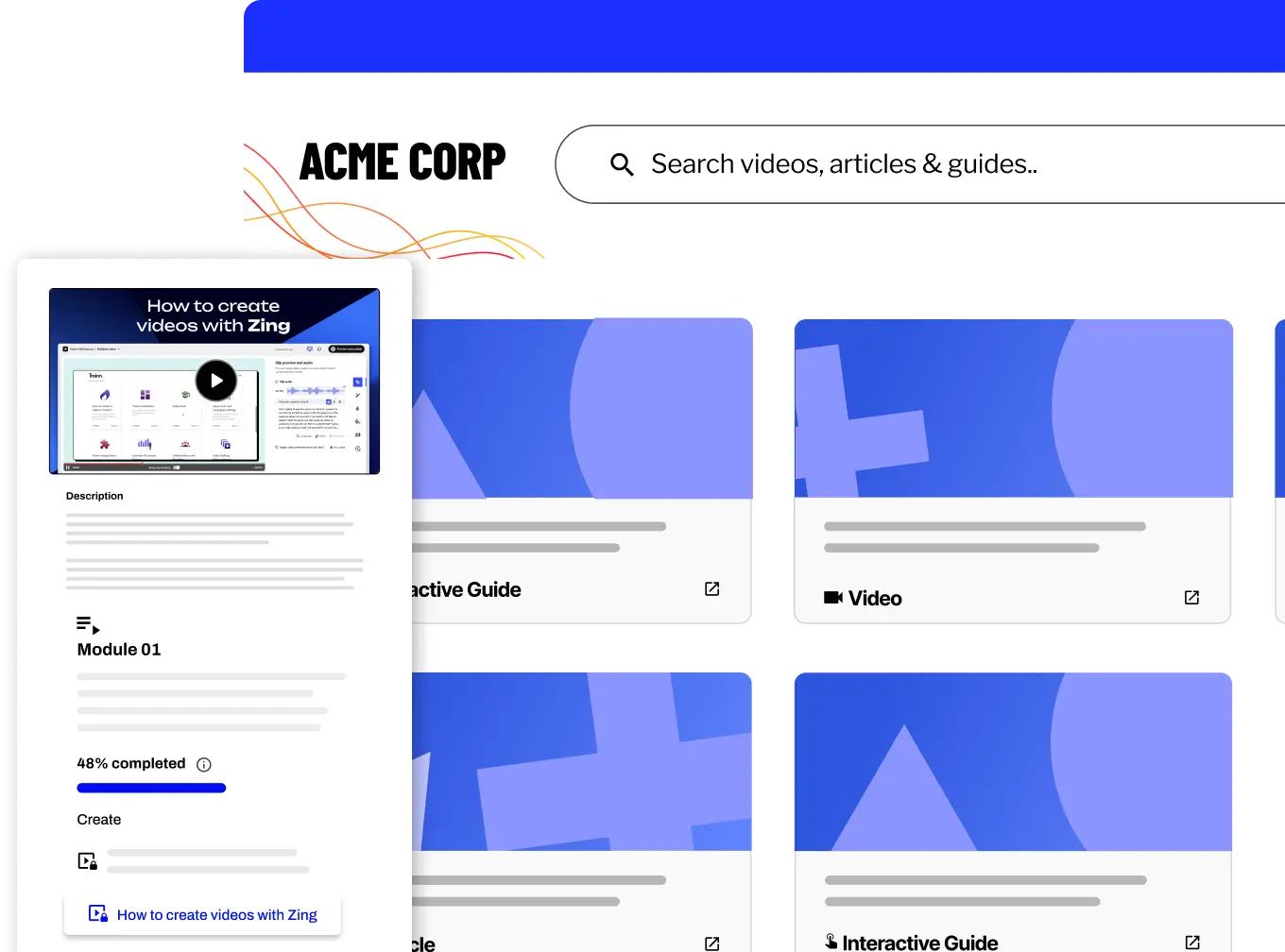- Features
- Resources
- Pricing
AI-Powered Customer Education Platform
Meet Trainn: One platform to create training videos & interactive guides, a customizable Knowledge Base, and a Training Academy.
Free for 14-days. No credit card required.
E-learning
What is E-Learning?
E-learning, short for electronic learning, refers to the delivery of educational content and training programs through digital platforms and the Internet. It encompasses a wide range of online learning experiences, from self-paced courses to interactive virtual classrooms. E-learning has revolutionized the way organizations approach customer education, enabling them to provide flexible, scalable, and cost-effective training solutions.
What are the Key Benefits of E-Learning?
- Accessibility: E-learning allows customers to access training materials and courses from anywhere, at any time, as long as they have any challenges like an internet connection, lack of engagement, etc.
- Personalized Learning: Many e-learning platforms offer adaptive learning paths, enabling customers to tailor their learning experience to their individual needs and preferences.
- Consistent Content: E-learning ensures that all customers receive consistent, up-to-date information, minimizing knowledge gaps or disparities.
- Cost Savings: By eliminating the need for physical classrooms, instructors, and travel expenses, e-learning can significantly reduce the overall cost of customer education programs.
- Scalability: E-learning solutions can easily accommodate large numbers of learners without compromising quality or incurring significant additional costs.
What are the Types of E-Learning?
- Self-Paced Courses: Interactive online courses that allow customers to progress through the material at their own pace, often incorporating multimedia elements, quizzes, and assessments.
- Virtual Instructor-Led Training (VILT): Live, online training sessions conducted by an instructor, enabling real-time collaboration and interaction.
- Webinars: Online seminars or presentations that customers can attend remotely, often incorporating Q&A sessions and interactive elements.
- Microlearning: Bite-sized learning modules that deliver concise information, making them ideal for just-in-time training and reinforcement.
- Simulations and Scenario-Based Training: Immersive digital environments that replicate real-world scenarios, allowing customers to practice and apply their skills in a safe, controlled setting.
Why is E-Learning Important in Customer Education?
- Global Reach: By leveraging e-learning platforms, organizations can deliver consistent and high-quality customer education to customers worldwide, regardless of location.
- On-Demand Access: Customers can access e-learning materials and courses at their convenience, enabling self-paced learning and reducing the need for in-person training sessions.
- Continuous Learning: As products and services evolve, e-learning platforms allow organizations to quickly update and disseminate new training content, ensuring customers have access to the latest information and best practices.
- Cost-Effective Scaling: E-learning is an efficient and cost-effective way to scale customer education efforts, enabling businesses to reach a larger audience without incurring significant additional costs.
- Analytics and Reporting: E-learning platforms often provide robust analytics and reporting capabilities, allowing organizations to track customer progress, identify knowledge gaps, and measure the effectiveness of their training programs.
What are Some Best Practices for Implementing E-Learning Effectively?
- Conduct Thorough Needs Assessments: Identify the specific learning objectives, target audience characteristics, and organizational goals to ensure that e-learning content is relevant and aligned with desired outcomes.
- Leverage Multimedia and Interactivity: Incorporate a variety of multimedia elements, such as videos, animations, and interactive simulations, to enhance learner engagement and knowledge retention.
- Foster Collaboration and Social Learning: Encourage customers to collaborate, share experiences, and exchange knowledge through discussion forums, social learning platforms, or virtual study groups.
- Implement Continuous Evaluation and Improvement: Regularly gather feedback from customers, analyze usage data, and refine e-learning content and delivery methods to ensure ongoing relevance and effectiveness.
What Tools or Technologies are Commonly Used in E-Learning?
- Learning Management Systems (LMS): Platforms like Trainn enable the creation, delivery, and tracking of online training courses, facilitating a centralized and organized learning experience.
- Authoring Tools: Solutions like Articulate Storyline and Adobe Captivate allow for the development of interactive, multimedia-rich e-learning content.
- Video Conferencing and Webinar Tools: Applications like Zoom and Microsoft Teams support live virtual training sessions and webinars, enabling real-time collaboration and interaction.
- Mobile Learning Apps: Responsive LMS platforms and dedicated mobile apps allow customers to access e-learning materials on-the-go, promoting flexibility and convenience.
- Learning Experience Platforms (LXPs): These modern platforms offer personalized learning experiences, social collaboration features, and advanced analytics for a more engaging and adaptive learning journey.
- Scorm or SCORM: The Sharable Content Object Reference Model (SCORM) is a widely adopted rule of e-learning software across different LMS platforms that ensures compatibility and interoperability.
What are the Challenges of E-Learning?
- Ensuring Learner Engagement: Maintaining customer motivation and engagement in an e-learning environment can be challenging, requiring creative instructional design and interactive elements.
- Technical Considerations: Implementing and maintaining e-learning platforms, ensuring compatibility with various devices and operating systems, and addressing potential technical issues can be complex and resource-intensive.
- Lack of Face-to-Face Interaction: Some customers may prefer or benefit from in-person, instructor-led training, as e-learning formats may lack personal touch and real-time feedback opportunities.
- Digital Literacy and Accessibility: Not all customers may have the necessary digital literacy skills or access to reliable internet connectivity, potentially creating barriers to participation and learning.
- Data Privacy and Security: Handling and protecting customer data and sensitive information in e-learning environments requires robust cybersecurity measures and compliance with data privacy regulations.
Further Reads: E-learning Challenges And How To Avoid Them
Trainn is the only AI-powered and no-code LMS that helps SaaS businesses build an enterprise-grade Academy to drive customer training and product education at scale. Using Trainn, you can author course content, build courses with quizzes, and launch your Academy with certifications and LMS analytics.
FAQs
1. Can e-learning effectively teach hands-on skills?
E-learning effectively teaches hands-on skills through simulations and virtual labs, offering practical learning experiences.
2. How can organizations ensure e-learning content quality?
Organizations ensure e-learning content quality by incorporating strong instructional design principles and leveraging subject matter experts' expertise.
3. Is e-learning suitable for complex technical topics?
E-learning is suitable for complex technical topics, utilizing interactive modules and scenario-based training to engage learners effectively and facilitate comprehension.




